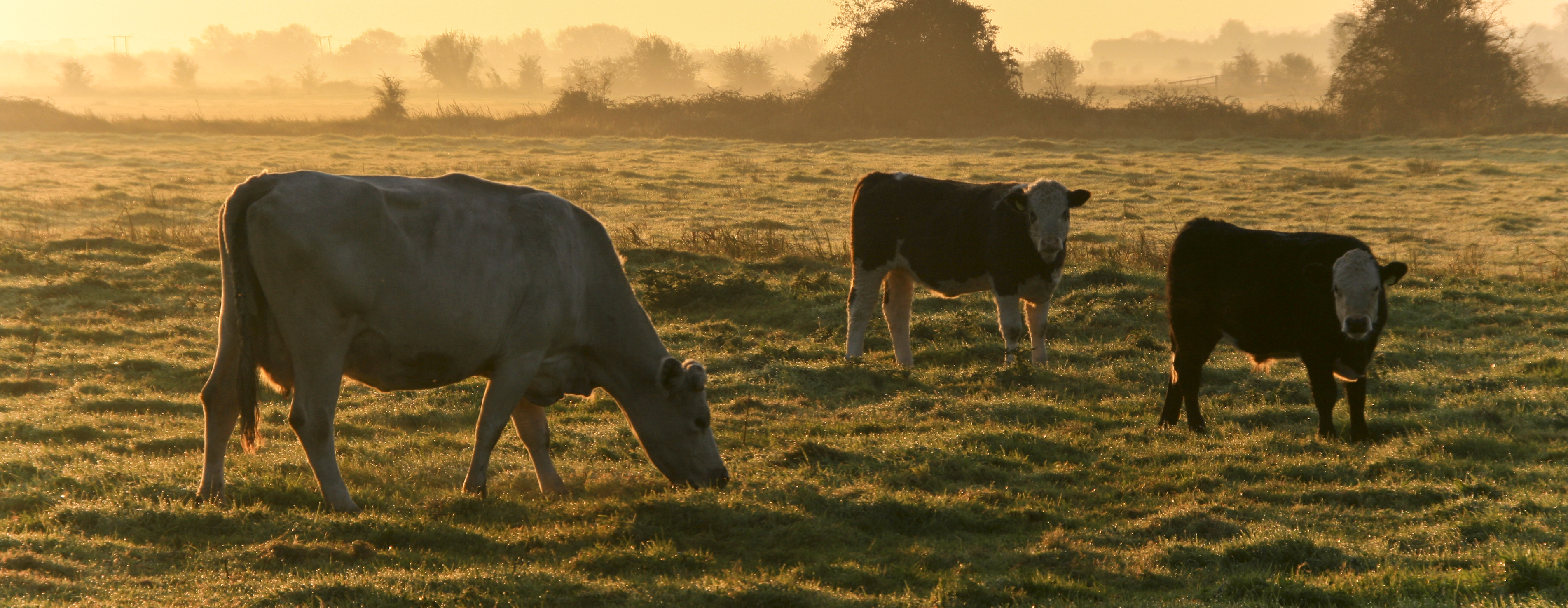Grain or Grass: Which Type of Beef is Better?

Grain or grass? Lately, it seems that grass fed beef is all the rage. From celebrities who swear it's the only beef they'll eat (even as celebrities who eat meat are becoming a dying breed), to a trend towards beef that doesn't come from so-called "factory farms," to claims that grass fed beef is healthier for your heart, people seem to be doing a lot of talking about the stuff. But is it all it's cracked up to be? How does it compare to "grain fed" beef? I'll address these questions in this blog post.
First, in order to discuss grass fed and grain fed beef, it's important to know how to define them. In legal terms, there isn't an actual definition for grass fed beef. In October 2007, the USDA passed formal guidelines to regulate the grass-fed label, in exactly the same fashion by which they regulate organic products: through audits and the granting of permits applied for by ranchers. There was a standard for what could be considered grass fed beef, and what could not. However, according to their website, the USDA withdrew these regulations in January 2016. The standards set in 2007 are no longer in effect, meaning anyone can claim their beef is grass-fed by simply applying for a permit. But since there's no standard, it's almost laughably easy to get one, and once you do, you can still feed your cattle grain! It's a win-win! Not.
Theoretically, though, grass fed beef is beef that is FINISHED on grass, and grass only. Why the emphasis on the word "finished?" We'll get there in a minute. This type of beef is advertised as being more natural because wild cattle graze grass, and nothing else. It is also advertised as being more humane because cattle roam pastures rather than being confined to cruel, cramped "factory farms" (They mean feedlots, which I would argue are quite humane. You can find out more them here). Supplementing grain is frowned upon (but not unlawful) for a grass-fed operation. So how can one tell the difference? The proof is in the fat. True grass-fed beef will have yellow fat due to the presence of carotenoids, and grain-fed beef will have white fat because it doesn't contain nearly as many carotenoids. Let's compare.
They're the same cut of meat (ribeye), but the one on the left is much darker and the fat is clearly a dark, yellowish color. That's because it's actually grass fed. Whoever produced it was honest about what they feed their cattle. Unlike this guy:
 |
|
|
In contrast to grass-fed beef, beef from cattle finished on grain tends to have an almost buttery flavor, have more marbling, and be more likely to grade choice, meaning it has a higher degree of tenderness, juiciness, and flavor. This is because cattle eat concentrates such as corn and sorghum, along with protein-rich feedstuffs such as cottonseed meal and dried distiller's grains. But again, this is only in the finishing stage.
Why all the emphasis on the finishing stage? Read these words carefully, and as many times as you need in order for it to sink in good and deep. Up until the finishing stage of production, which is typically only the last three months or so of their lives, ALL CATTLE ARE GRASS FED.. Let me explain. The first two stages of production, the cow-calf stage and the stocker stage, revolve around high-quality perennials like sideoats grama and jiggs bermuda which are (you guessed it!) grasses. The nutrient value of these grasses is incredible, and they help ensure cattle are eating healthy, well-balanced diets. Ranchers will sometimes supplement a bit of grain or some molasses to help the cattle through the winter months, but that's it. It's too expensive otherwise. So the difference between grass fed beef and grain fed beef refers only to the finishing stage of production, which is only about three months long. Therefore, all cattle eat grass for the majority of their lives.
So how does grass finished beef compare to grain finished beef? Grain finished beef tends to be more palatable, offering a higher degree of marbling, which adds a higher degree of tenderness, juiciness, and flavor. As a result of that extra fat, it tends to be higher in calories. Don't let fat frighten you, though! Grain finished beef contains more monounsaturated and polyunsaturated fat (aka the "good" fats found in foods like avocados) than grass finished, and grass finished beef has a larger amount of saturated (aka "bad" fat) than does grain fed. See here and here for proof. In addition, grass finished beef tends to contain a larger amount of Omega 3 fatty acids than grain finished, but the difference is negligible. There is no recommended daily intake of Omega 3s set by the U.S. government, but U.C. Berkeley recommends a daily intake of about 1,100mg per day for women and 1,600mg for men. According to the Texas A&M Animal Science department, grass fed beef only contains an average of 55mg in one quarter pound hamburger patty. That's only 5% of the recommended daily intake for women, and a little over 3% of the recommended daily intake for men. In contrast, a salmon fillet proudly sports 1,100mg, and a tablespoon of canola oil contains 1,400mg. Since the Omega 3s in grass fed beef are arguably insignificant when you look at those statistics, is all that extra saturated fat in grass finished beef worth it? Another nugget I'd like to throw in from that Texas A&M paper I mentioned earlier is that even though some people say grass finished beef is lower in cholesterol, there is no difference in cholesterol levels when the fat content is similar. Just food for thought. If you have time, I'd recommend that you read the entire paper. It's quite fascinating.
Grass finished beef also has a higher carbon footprint (Gasp! Shock! Horror! I thought doing things the way nature intended was better for the environment?!?!?!). Again, let me explain. Cattle are ruminants, meaning they have a four-chambered stomach. The largest chamber, the rumen, acts as a huge fermentation vat, where billions of microbes (bacteria, fungi, and protists), effectively pre-digest whatever food the cattle eat. The fermentation process provides the microbes with food so they can survive, and the waste products (Acetate, Propionate, and Butyrate) are used by the animal as a source of calories and other derived nutrients. However, depending on what type of food the cattle are eating, it can be easier or harder for the microbes to digest the food. This means that acetate, propionate, and butyrate are produced in varying quantities depending on diet. This is important because fermentation also produces by-products in the form of methane (CH4) and carbon dioxide (CO2). Both are greenhouse gasses, although methane is worse for the environment than carbon dioxide. However, these gasses (especially CH4) are also produced in varying amounts based on diet. The cell walls of plants like grass contain a large amount of a structural carbohydrate called "cellulose" that makes it incredibly difficult to get the goodies within the cell. This is why humans, pigs, and other non-ruminants can't subsist on grass alone like ruminants can. We don't have rumen microbes, so we can't digest cellulose. We can only digest nonstructural carbohydrates like starch, lactose, and fructose. Unfortunately, because it's so difficult to digest cellulose, ruminant animals use different sets of microbes to break it down than they would to digest the nonstructural carbohydrates (starch) in corn. These microbes used to digest cellulose tend to produce a higher amount of acetate, less propionate, and a small amount of butyrate in about a 70:20:10 ratio. The completely different set of microbes used to digest corn and other grains produce acetate, propionate, and butyrate in about a 55:35:10 ratio. In other words, less acetate, more propionate, and the same amount of butyrate. Out of these three by-products, acetate production requires the most methane. In contrast, propionate production actually USES UP CH4. Propionate is a hydrogen sink, meaning it requires extra hydrogen to produce. The chemical reaction acquires this extra hydrogen by stripping it from the methane, thereby reducing methane emissions. This means that when more propionate is produced, as occurs when cattle eat more concentrated feeds like grain that contain nonstructural carbohydrates like sucrose and starch, far less methane is produced because the microbes need it to make propionate. When they eat grass, there's a ton more cellulose to digest and not near as much starch. More acetate is produced, and therefore more methane. Oklahoma State University published findings that clearly show that grass fed beef indeed has a larger carbon footprint, even factoring in manure recycling and soil aeration due to treading on grass. I learned all this stuff about carbohydrate fermentation in my animal nutrition class at Texas A&M so I don't have a source other than the notes I took that explains the exact process in the detail that I just did, but here's a source that proves more propionate is produced from a high concentrate diet. And since the OSU findings also confirm what I just said, you can be assured that what I just said is true. If it weren't, I wouldn't pay tuition to learn it from people with PhD's, who make a ton more money than I do.
So there you have it! These are the main differences between grass finished and grain finished. My main goal with this post is to inform you, the consumer, about what you're eating with all the facts and none of the pseudoscience. To be clear, I'm not telling you to eat one type of beef or the other. That's your decision. My main purpose is to explain a little bit more about what exactly grass fed beef is, so that you better make your choice and so you can understand exactly what you're paying for. Hopefully that's what you take away from this. You don't need to sacrifice your health for flavor, and if you're a beef producer, thanks for what you do for agriculture, no matter what type of food you finish your cattle on.
I'm a full-time college student at Texas A&M University, where I'm in the process of getting my Animal Science degree, with eventual aspirations to go to law school and work as a consulting lawyer for agriculture corporations. I grew up around animals, and currently manage an operation that breeds show-quality boer goats for 4H and FFA exhibitors. My family also raises commercial cattle in south Texas.



Comments
Post a Comment